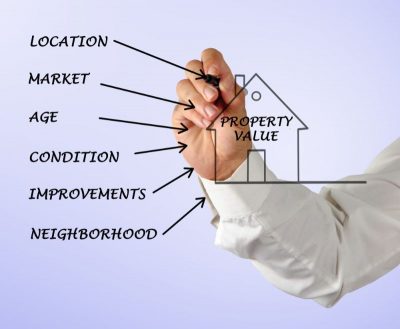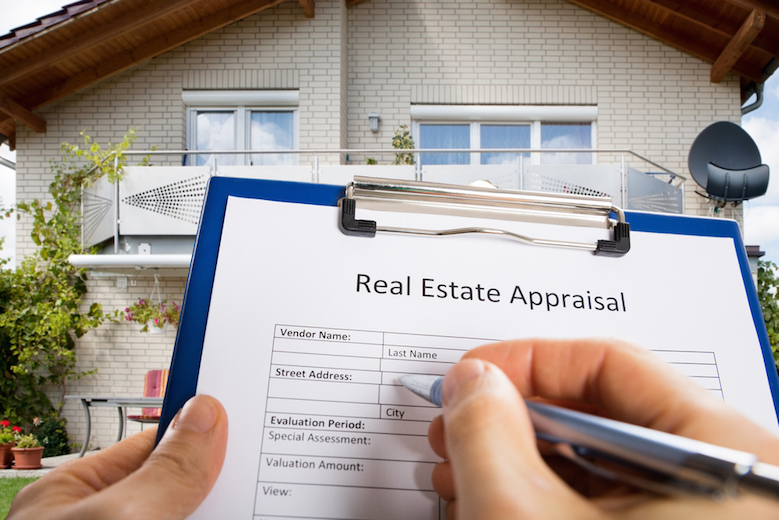Home appraisers value property by doing a walk-through of the house and then using one of two standard valuation methods: either the “sales comparison approach” or the “cost approach.” Occasionally, an appraiser might apply both valuation methods in an effort to pinpoint an extremely accurate value. A home appraisal provides the best determination of a home’s value.

The Walk-Through
Unlike other forms of home valuation, such as reports put together by real estate agents, home appraisals are prepared by licensed home appraisers. These professionals look at a variety of factors when valuing real estate. Among other things, they consider a home’s size, layout, and how well it has been maintained. They also factor in surrounding properties and recent sales of similar homes.
The walk-through is the first step in a residential home appraisal and easily the most important part of the entire process. During this step, the appraiser visits the home and performs a visual inspection of the inside and outside of the property. He also notes things that add value such as amenities and upgrades.
Exterior
The appraiser usually begins by visually inspecting the house’s exterior, examining the overall structure and assessing the materials used to construct the home. He will pay close attention to the home’s foundation to determine if there are any cracks or signs of water damage. Although a home appraiser is trained to look for obvious signs of disrepair, he is not a home inspector.
Interior
Although the appraiser doesn’t assess a home’s value based on décor, a clean, well-maintained home will show better than one that is cluttered and dirty. Staging the home can dramatically increase its value. Appraisers look at the essential building materials used to construct the inside of the home, including flooring, light fixtures, windows, and doors. The appraiser also considers the square footage and number of bedrooms.
Amenities
While the appraiser is inside, he will look at the home’s amenities, which include all the little extras that make a house more comfortable. Amenities like central air conditioning, carbon monoxide detectors, security systems, and custom window treatments set a house apart from other properties and can increase market value.
Upgrades
Major upgrades can dramatically raise a home’s price. The home appraiser will consider things like new kitchen cabinets, appliances, or countertops. Likewise, a recently remodeled bathroom can add thousands of dollars to a property’s appraised value. If you upgrade your home, it’s important to keep your receipts and invoices so you can prove how much you spent on materials and labor.

Home Valuation Methods
After the walk-through, the home appraiser will apply one of two valuation methods to assign a final value to the home. In some cases, an appraiser might use a combined approach to get the most accurate number possible.
Sales Comparison Approach
By far the most popular appraisal method, the sales comparison approach determines a home’s fair market value by comparing it to similar homes that have recently sold in surrounding neighborhoods. Professionals in the industry often refer to these properties as “comparables” or “comps.”
Because no two houses are exactly alike, the appraiser factors in price adjustments for all the differences between the comp homes and the house being appraised, which is referred to as the “subject property.” For example, if “comp A” has granite countertops and the subject property has laminate, the appraiser subtracts the value of the granite from the subject property’s total value. The appraiser continues to make adjustments for several comps, raising or lowering value based on differences in lot size, amenities, fixtures, appliances, finishes, and overall upkeep.
Cost Approach
The cost approach attempts to calculate the cost of replacing the entire home using local construction materials and labor. Using the following steps, the appraiser calculates what it would cost to rebuild the home from the ground up.
- First, the appraiser determines the value of the lot.
- He estimates the cost of reproducing the home.
- He considers the home’s age and condition to calculate depreciation.
- He subtracts the depreciation figure from the total replacement cost of a brand new structure.
- He adds in any external improvements, such as pools, landscaping, storage sheds, and decks.
- He adds the lot value to the total value of improvements and depreciated value to arrive at an accurate replacement cost.

When the Report Is Finished
Home appraisals cover a home both inside and out and every detail in between. The goal is to get the most accurate snapshot of the house’s current condition. When the appraiser is finished, he prepares a detailed analysis of the property and assigns it a market value. At minimum, the home appraisal report will include:
- A description of the exterior and interior of the property and any major improvements
- A brief description of the home’s setting, such as a new development or rural property
- The home appraiser’s opinion of the quality of the neighborhood and surrounding area
- A statement regarding available area amenities, such as access to parks, shopping, schools, and public transportation
- A list of at least three comparable homes that have recently sold in the area and an analysis of their features
- Identification of any problem areas that seriously detract from the home’s value, such as mold or a structural defect
- The appraised value
If the Appraisal Isn’t What You Expect
If you obtained a home appraisal in preparation for selling your home, don’t be discouraged if it comes back lower than you anticipated. Performing an appraisal before you list gives you an opportunity to correct problem areas that might deter buyers from making an offer. Fortunately, many items are easy fixes you can tackle on your own. Do-it yourself home improvements are an economical way to add instant value to a home. Making changes now will save you time and money in the long run.
